We independently evaluate all recommended products and services. Any products or services put forward appear in no particular order. If you click on links we provide, we may receive compensation.
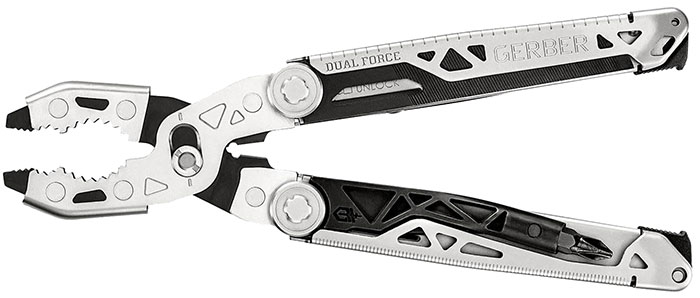
Stagnation has been a problem in the multitool market for quite a while now. What I mean by that is that while there continue to be new tools coming out from the big names in this market, they tend to be new variations on the same basic idea, rather than a really new concept or a unique solution to a problem. This is frequently referred to as evolution versus revolution, and there’s certainly nothing wrong with evolution. For instance, the difference between a Leatherman Wave and a Wave Plus is the integration of replaceable hard wire cutter bits in the plier head. That’s an upgrade, but that’s not a revolutionary change.
Some new startup brands have been looking at revolutionary takes on the multitool, like GOAT Tools with their modular tool platform (on Kickstarter and Indiegogo) as well as the funky Toler Union multi-piece tool setup. But in terms of mainstream brands trying actually new ideas out, the only one is Gerber.
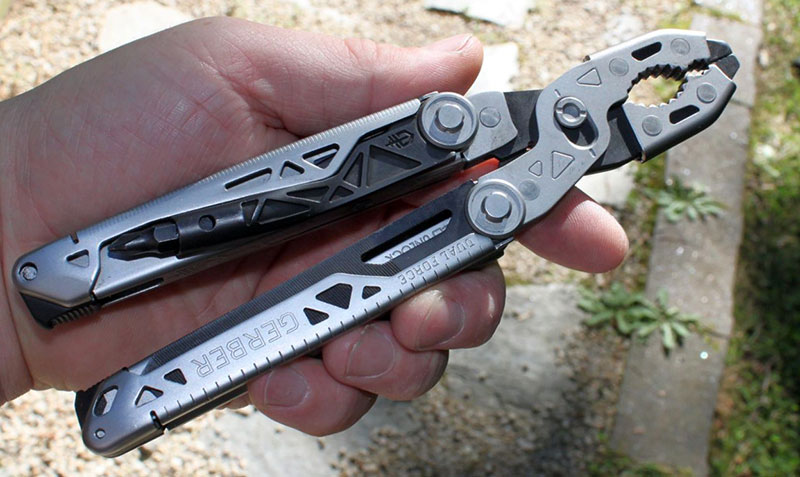
While Gerber’s knives tend to be relatively conservative in nature, their multitools are anything but these days. The Center-Drive Plus was particularly interesting, even though it really just added a fresh take on the classic bit driver to Gerber’s one-handed (out the front) tool formula. A lot of their smaller tools (Armbar, Lockdown, Stake-Out, Devour Titanium Spork, etc) are borderline bizarre. But when spy photos of the Dual Force first broke cover late last year, it was obvious this was going to be a big deal.
Gerber Dual-Force
12
12 oz
3.25″
4.65″
Fabric
China
The Dual Force is a folding pliers based multitool, obviously, but some of the basic concepts around that idea have been modified. The Dual Force has a slip-joint plier head, an exceedingly rare feature in this market, giving you a narrow or wide position for what you’re gripping. It also eliminates almost all the “fluff” that’s inherent in most multitools, ONLY providing full sized working tools and no small add-ons. It’s a refreshing take on a pliers based multitool in so many ways, and I was eager to put it to the test in the shop for my full-time job as a mechanic. Let’s take a closer look at the Dual-Force.
Primary Implements
On a tool with so few implements, the primary implements are the plier head and the handles, which in and of themselves deserve close examination – they’re the entire point of the tool, after all. There are multiple noteworthy things about these pliers, first and foremost of which is that they have a slip joint – like the two-position adjustable jaw pliers you find in your home tool kit. While every other folding multitool currently on the market offers fixed position pliers, the Dual-Force lets you switch from a narrow to a wide position depending on what you’re grabbing. The plier head itself is layered construction rather than the typical cast head on other tools, which (according to Gerber) gives the tool twice the torsional strength – resistance to twisting – than other comparable tools.

It also has a relatively blunt tip rather than the usual needle-nose tip most of these tools use, and the inside of the head has very large pronounced teeth instead of the typical fine teeth. Two separate “pipe grip” areas (the curved portions with gripping teeth, called that because they’re designed to grab a pipe without crushing it) allow you to grab small or large objects depending on where you position the plier head. The pliers also incorporate a wire cutter and wire stripper behind the fulcrum point of the pliers.
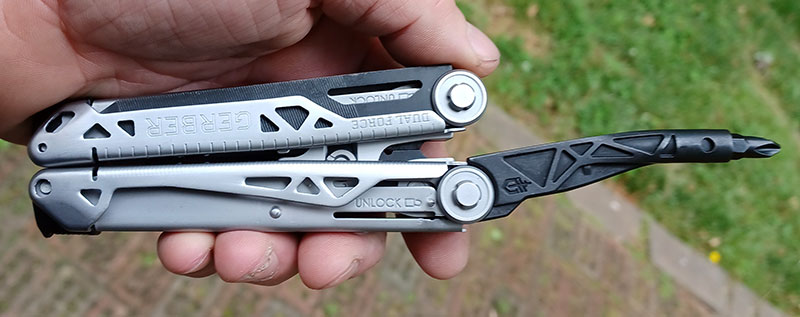
The handles themselves are also not your typical fare for a folding multitool, offering significantly less “splay” (the distance between the ends of the handles when open) because of the offset of the distance between the pivots and the distance between the ends – normally straight on a lot of tools when closed, but negative on the Dual-Force. This means you don’t have to open your hand as wide to apply force to the pliers, which allows you to more effectively clamp on things.
Secondary Implements
Secondary implements are limited but focused on the Dual-Force. There are four full sized tools, all outside accessible and all of which lock securely in place with liner lock mechanisms. They’re also all one-hand opening assuming you’re dexterous enough to do so with your non-dominant hand. You have a full-size plain edge blade with a thumb hole opener, a cross-cut wood saw, a dual-pattern metal file, and a center-drive bit driver. There is also on-board storage for two hex bits in the handles.

The blade itself is quite large for a multitool, measuring 3.25” long and a relatively beefy 0.113” at the spine. This is a pretty heavy-duty blade, only tapering down to 0.053” behind the edge, so it’ll be better at cutting difficult materials than it will at cleanly splitting an apple. Probably not a food prep knife. Blade steel is not listed in the specs on Gerber’s website, but it does have a protective black coating on it to prevent corrosion. The grind is a mid-height saber grind, also not contributing to the blade’s slicing abilities.
The blade is accessed by the thumb on the right hand, as is the metal file/chisel on the opposite side of the tool. Gerber packs a lot of function into this single piece of steel, with a coarse (single cut) file on one side, a fine (dual cut) file on the other, a coarse cut pattern on the underside (to be used as a rudimentary metal saw in a pinch) and a smooth spine. The end has a chisel ground into the tip, giving you leverage to scrape and pry things with the whole tool, similar to the file on the Lockdown tools. Unlike those, there’s no thumb “stud” in the way of the file, which is great. It also has the black paint coating on it, which doesn’t make sense on a file – it’s going to wear off with use, and it also makes the surface of the file less abrasive. I’m sure it was done for aesthetic reasons but they’d be better off skipping it.
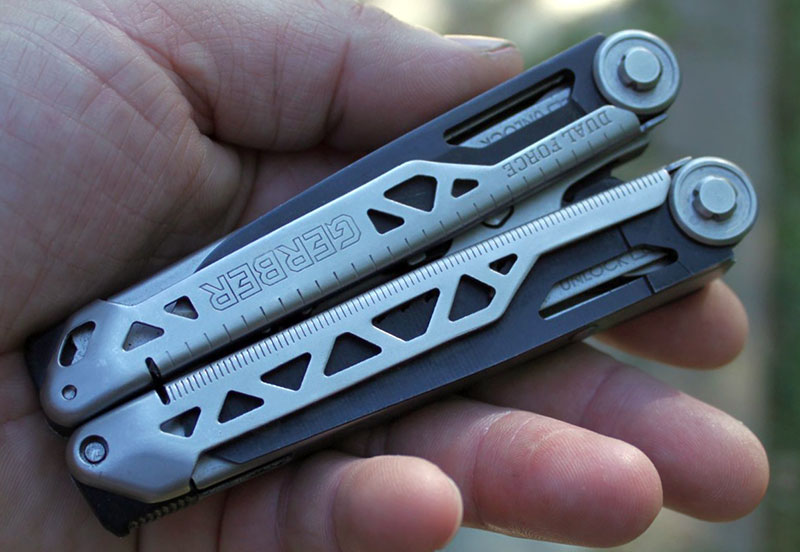
The other tools are accessible with the left-hand thumb, the first being the wood saw which uses a thumb hole to open. The saw measures 3 3/8” long, with a 3” cutting edge and a 0.053” spine. It’s a cross-cut pattern (meaning the teeth alternate and face inward) and it’s designed for pull cuts, not back-and-forth cuts like a larger saw, but the aggressive pointy teeth will make quick work of whatever wood it’s put through.
Finally, Gerber has integrated the innovative bit driver from the Center-Drive models to the Dual-Force. The bit driver was the whole party trick behind the Center-Drive, and it’s equally successful here. It’s held closed with an integrated detent, swinging out and locking in place so that when open it’s in line with the center of the handle rather than offset to one side, making it much more natural to use as a screwdriver. It uses a built-in magnet to retain the ¼” drive standard hex bits in place. It’s also usefully long, around 3.25” with a bit in it, giving it much more reach than a lot of bit drivers on competitors. There are two bit holders integrated into the ends of the handles opposite from the pivots, which flip outward to allow access to the bits, both also held in place via magnetic retention.
It’s worth mentioning that the handles themselves are a tool, with ruler markings along the sides and numerals on the insides of the handles – metric on the left, standard on the right, measuring up to 8mm or 3” per handle.
Features, Fit & Finish
As far as features go, the Dual-Force comes out of the box with a nylon carry sheath with a Velcro closure, which is set up for horizontal or vertical carry. Curiously, it does not come with a bit kit – more on that later – just a nylon sheath. There are some neat built-in features on the tool, like the aforementioned ruler markings on the scales, but there’s also a set of lines on the plier head and another set of lines on the fulcrum pivot which help you visually line up where jaws need to be positioned to slide between narrow and wide opening. There are also some decorative elements to the tool – the oddly shaped triangles etched into the plier head matching the triangles cut out of the handles are purely just for aesthetic reasons. The backsides of the handles in the closed position also have some decorative milling and a Gerber logo, and both sides feature the brand and name of the tool etched in as well.
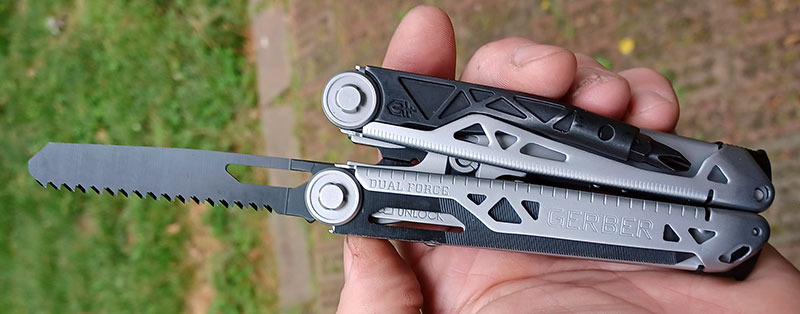
Fit & Finish is always the sticking point with Gerber multitools, and this one’s a mixed bag. Some parts of it are very solid feeling, particularly the whole plier head and the center-drive bit driver. The extra bit holders feel chintzy (and one of them broke during testing), and the chisel edge applied on the end of the file was really rough and chewed up out of the box. But honestly, my biggest quality/fit & finish complaint is the same feeling of “rattly-ness” that the Center-Drive suffers from, the whole tool wiggling around more than I’d like with the handles closed.
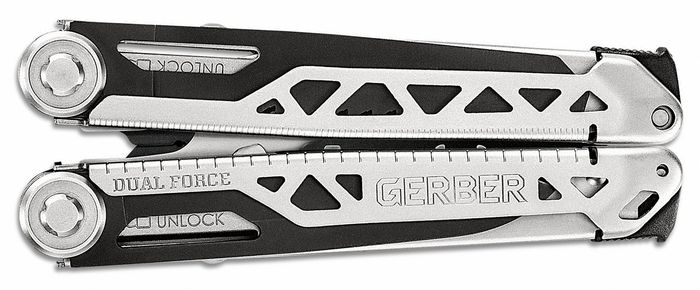
You can grab both handles and move them apart about a half inch vertically from each other, with a weird clicking noise emanating from the pivot of the pliers. The handles also don’t line up at all when closed, which is sure to bother your OCD sensitivities. This is probably a result of the slip joint plier head design, but it’s just a bummer. Leatherman tools don’t do this. All of the tools on the outside are tough to deploy with the exception of the bit driver, and both the file and the saw rub against the handles when you’re opening them – the blade and bit driver do not. These things don’t ruin the function of the tool, but they detract from the enjoyment.
Field Test
The first thing to note about the field test is carrying the Dual-Force: this tool is heavy. No kidding. It weighs 12 ounces, making it comparably heavy to the Leatherman Surge. The ballistic nylon sheath it comes in suits the purpose of carrying it just fine – it fits in snugly, and I’m a fan of nylon sheaths over other types, but it doesn’t have room for both a bit kit and the Dual-Force – the top won’t close. I like to carry a bit kit with me when carrying a tool this size (especially considering it has the center drive bit driver!) so I wound up doing a bit of mix and match, combining the leather Berry-compliant sheath and ¼” hex bit kit from my Center-Drive Plus with the Dual-Force, which allows you to carry all of them together. This oddly works out because the Center-Drive fits nicely in the nylon sheath the Dual-Force came in as well.

You just have to be sure to leave the bit driver side of the tool facing outwards, otherwise it will poke through the open back of the sheath and into your waist. But this is really a configuration I encourage Gerber to consider selling this tool as – with the large leather sheath and bit kit included. Seeing as how the tool weighs ¾ of a pound(!) there is not a pocket clip, and nor should there ever be. As it is, the weight of the tool and sheath combined can even cause a leather belt to sag at end of a long day. Still, it’s a heavy-duty tool, not a piece of EDC gear to slip into your pocket, so complaining about weight seems a bit silly.
I was very excited to carry and review the Dual-Force during my full-time job as a mechanic, because it seems exceptionally well-suited to tasks that I normally ask of a multitool – i.e., serving as a makeshift toolbox to save me time walking back to my tool chest. One of the things I most frequently use – or more accurately, misuse – my other multitools for is to hold the nut on a caliper guide pin in place while I loosen or tighten the bolt that secures the caliper to the bracket. These nuts like to spin, and you can spend several minutes fishing around in your drawer to guess and check what size the nut is with a combination wrench, or you can just whip out your multitool and grab the nut with pliers to hold it in place while you hit the bolt with an impact tool.
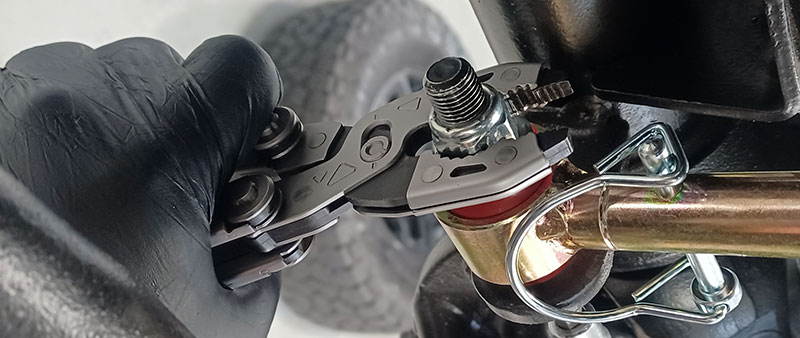
In a flat-rate industry, time is money, and the pliers on the Dual-Force are money, being able to open up wide and confidently grab the edges of a nut, then also apply a lot of force to keep it from spinning and rounding off. I don’t even both to go get a combination wrench to do this task anymore because the Dual-Force is so good at it. It’s also really superb when assembling flat-pack furniture which requires you do the same concept: hold a nut in place to tighten down the bolt that threads into it. The sharp triangular teeth in the jaw fit well on a variety of hex bolt heads provided they aren’t already rounded off, and the ergonomics of the handles let you put a lot of force of them. Ironically, this achieves what SOG’s Compound Leverage pliers fail at, even though they’re designed to apply more force, because you have to open them so wide you can’t get a grip around the handles. For mechanics, these solid pliers are a total game-changer, and the layered construction means you don’t have to be as worried about them snapping when you twist something as the cast pliers on the competition.

The lack of a needle-nose tip is sometimes a letdown, as I find them useful for pulling fuses or staples, but the blunt nose also lets you get closer to what you’re working on, so it’s a trade-off. I like the design of the small and regular sized pliers inside the head too, allowing you to adapt to different sized objects. Really excellent pliers. The wire cutters on other side of the fulcrum work in a pinch, but with electrical wiring repairs I always just go and grab the real tool. Maybe if Klein brought back the Electrician’s Hybrid Plier I’d change my mind, but until then I’ll stick with dedicated strippers and crimpers. The only real downside is that the slipjoint mechanism makes them harder to close: if they’re in the narrow position and you try to fold both handles in at the same time, sometimes the slipjoint will open up while you’re applying pressure, and either jam in place or fold up in the open position, which is very wide and doesn’t fit into the sheath. The solution to this is to fold one arm up at a time, holding the plier head with one hand and folding with the other, to prevent the slip joint from opening. A nuisance but you get used to it.
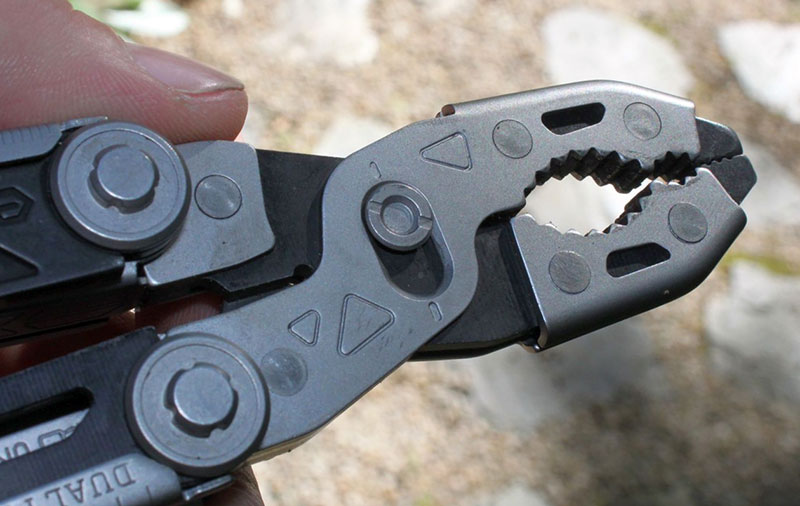
The rest of the tools are just sort of along for the ride, honestly. I love the bit driver just as much as I did on the Center-Drive, so that’s always a plus – it is another trip to the toolbox-saver, with the long reach of the driver letting you get into places you couldn’t normally reach, but the shape and weight of the handles makes it more awkward to use than on the original Center-Drive tool. During my time carrying it, one of the detent balls on the bit holders broke off, allowing it to “free spin” (pass through the inside of the handle and all the way around) rather than just flip out, which isn’t surprising considering they’re plastic. I appreciate that the blade is full-sized and has a plain edge instead of a combo edge, but like most multitools I carry it doesn’t get a lot of use because I’ve already got a knife in my pocket that’s sharper, easier to get to, and easier to open.
The file/chisel is probably the second most useful after the bit driver, offering both textures as well as a textured edge, and the ability to pry and scrape with the end. It would be much better if it wasn’t painted, Gerber – files don’t need to be painted! Finally, the saw. I’m not a camping guy, but I did try this saw out in my back yard and can confirm it will cut through a sapling or small branch with ease. It also will do a real number on thick rope if you need to. I’d honestly prefer scissors in this spot, but it’s a good saw.
Alternatives
All these knives available at BladeHQ.
The Gerber Dual-Force presents a compelling value proposition, both because it has something no other multitool does (namely, the slip joint layered-construction plier head) and because the price seems pretty reasonable at $110 MSRP. The Dual-Force is currently sold out at time of writing and hard to find anywhere except for Gerber’s website, but SMKW did list retail price at just below $80, so it’s a real bargain for what you get.The most comparable size-wise is the Leatherman Surge, which is significantly more expensive: it has an MSRP of $140 and is not discounted at BladeHQ. It does offer a lot of features that the Dual-Force doesn’t: replaceable wire cutters in the head, a pair of full-size sprung scissors, a can/bottle opener, a unique blade exchanger that lets you switch between a double-sided file (wood/metal and diamond coated) and a saw blade, as well as using Leatherman’s proprietary double-sided flat bits – which you can view as a feature or a bug depending on your opinion. It is certainly a better-built tool in terms of fit and finish, but whether it’s worth nearly double the price is up to you, and it doesn’t offer the unique slip joint heavy-duty pliers that the Dual-Force does. The Surge is similarly pocket-unfriendly, with a 12.5-ounce weight meaning no pocket clip for you.

Another competitor to the Dual-Force is the Victorinox Swiss Tool, the full-sized original design and not the more EDC-friendly Spirit. The Swiss Tool offers all the exemplary build quality of Swiss Army Knives in a full-sized butterfly style multitool, with polished stainless box handles. It’s pricey at ~$120 and getting a little behind the times (no bit exchanger, small plier head, no party tricks) – but it’s got a great blade, great file, and excellent build quality.
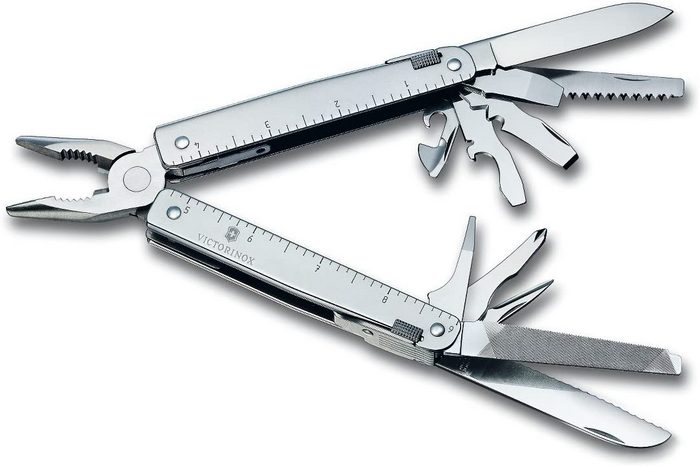
Finally, don’t mind the bulk and want to try something different? How about the NexTool Flagship Pro, available on Amazon for only ~$40. It also brings something different to the table: it’s double-hinged, so it has three “arms.” Open it one way, and it’s a set of needle nose/regular pliers, complete with replaceable hard wire cutters. Open it the other way, and you have a full-sized set of spring scissors. The whole double pivot concept is fresh and hasn’t gotten the recognition it really deserves, but the Flagship Pro also brings a full sized wharncliffe blade, a wood saw, package cutting hook, can opener and bottle opener, even a carbide glass breaker and ruler markings on the scales. It weighs in around 8.6 ounces. At that price, it might be worth rolling the dice on a newcomer brand.

Wrap-Up
Gerber really went for something different with the Dual-Force, and I appreciate that. It’s a heavy-duty multitool that just focuses on being that: heavy-duty. Obviously, the slip-joint plier head with strengthened construction is the star of the show here, as are the improved ergonomics when bearing down on the handles – it makes it an actual replacement for a set of pliers rather than a makeshift tool. If you’re a plumber, carpenter, mechanic, or other tradesmen that actually uses your multitool for real tasks on a daily basis, the Dual-Force is really worth consideration. If you’re looking for a multitool for EDC, this is not it. It doesn’t really have tools for that, and I don’t think that’s what it was designed for anyway. But the tools it does have are all full-sized, easily accessible, lock securely into place, and do real work: especially the center drive bit driver, which is just as revolutionary here as it was on its namesake tool. And when you consider the retail price point of around $80 (when it’s in stock) it’s even more appealing.
- Revolutionary slip-joint plier head, extra strong jaws, improved ergonomics, all full sized tools and no fluff, excellent center drive bit driver
- Difficult to close, fit & finish issues, very heavy, no scissors or bottle opener, painted file
Gerber Dual-Force Multitool
Quality/Performance - 75%
Value for Money - 79%
77%
Gerber drops something different in the Dual-Force: a multitool that’s not a stopgap, but a real tool for tradesmen.





